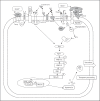Role of intestinal mucins in innate host defense mechanisms against pathogens
- PMID: 20375571
- PMCID: PMC7312850
- DOI: 10.1159/000163037
Role of intestinal mucins in innate host defense mechanisms against pathogens
Abstract
Gastrointestinal mucins produced by goblet cells comprise the main structural components of the mucus layer. Mucins play a critical role in the maintenance of mucosal homeostasis and are responsible for the differential effector and regulatory responses against a plethora of microorganisms, including commensals and pathogens. In this review, we present a comprehensive overview on mucin biology, its properties, classification and gene assembly. We also consider the structure of the mucin gene, its proteins and its role in innate host defenses. We compare the various mucin secretagogues and the differential regulatory pathways involved in mucin biosynthesis and secretion during normal and diverse pathogenic conditions. Finally, we summarize the putative uncharted aspects of mucin-derived innate host defenses, whose exploration will help drug developers to identify factors that can strengthen mucosal integrity and will facilitate basic science research into curative treatments for gastrointestinal diseases.
Copyright 2008 S. Karger AG, Basel.
Figures



Similar articles
-
The front line of enteric host defense against unwelcome intrusion of harmful microorganisms: mucins, antimicrobial peptides, and microbiota.Clin Microbiol Rev. 2006 Apr;19(2):315-37. doi: 10.1128/CMR.19.2.315-337.2006. Clin Microbiol Rev. 2006. PMID: 16614252 Free PMC article. Review.
-
Mucin dynamics and enteric pathogens.Nat Rev Microbiol. 2011 Apr;9(4):265-78. doi: 10.1038/nrmicro2538. Nat Rev Microbiol. 2011. PMID: 21407243 Review.
-
Intestinal goblet cells and mucins in health and disease: recent insights and progress.Curr Gastroenterol Rep. 2010 Oct;12(5):319-30. doi: 10.1007/s11894-010-0131-2. Curr Gastroenterol Rep. 2010. PMID: 20703838 Free PMC article. Review.
-
Entamoeba histolytica-Induced Mucin Exocytosis Is Mediated by VAMP8 and Is Critical in Mucosal Innate Host Defense.mBio. 2017 Oct 3;8(5):e01323-17. doi: 10.1128/mBio.01323-17. mBio. 2017. PMID: 28974617 Free PMC article.
-
Development and Functional Properties of Intestinal Mucus Layer in Poultry.Front Immunol. 2021 Oct 4;12:745849. doi: 10.3389/fimmu.2021.745849. eCollection 2021. Front Immunol. 2021. PMID: 34671361 Free PMC article. Review.
Cited by
-
High beta-palmitate fat controls the intestinal inflammatory response and limits intestinal damage in mucin Muc2 deficient mice.PLoS One. 2013 Jun 12;8(6):e65878. doi: 10.1371/journal.pone.0065878. Print 2013. PLoS One. 2013. PMID: 23776564 Free PMC article.
-
Neonatal colonization of mice with LGG promotes intestinal development and decreases susceptibility to colitis in adulthood.Mucosal Immunol. 2017 Jan;10(1):117-127. doi: 10.1038/mi.2016.43. Epub 2016 Apr 20. Mucosal Immunol. 2017. PMID: 27095077 Free PMC article.
-
Is the colon mucosa affected by ten days of gastric restriction in an animal model?Acta Cir Bras. 2019 Aug 19;34(6):e201900610. doi: 10.1590/s0102-865020190060000010. Acta Cir Bras. 2019. PMID: 31433001 Free PMC article.
-
Autophagy: roles in intestinal mucosal homeostasis and inflammation.J Biomed Sci. 2019 Feb 14;26(1):19. doi: 10.1186/s12929-019-0512-2. J Biomed Sci. 2019. PMID: 30764829 Free PMC article. Review.
-
Effects of dietary Bacillus amyloliquefaciens supplementation on growth performance, intestinal morphology, inflammatory response, and microbiota of intra-uterine growth retarded weanling piglets.J Anim Sci Biotechnol. 2018 Mar 13;9:22. doi: 10.1186/s40104-018-0236-2. eCollection 2018. J Anim Sci Biotechnol. 2018. PMID: 29564121 Free PMC article.
References
-
- McCracken VJ, Lorenz RG. The gastrointestinal ecosystem: a precarious alliance among epithelium, immunity and microbiota. Cell Microbiol. 2001;3:1–11. - PubMed
-
- Gum JR, Jr, Hicks JW, Gillespie AM, Carlson EJ, Komuves L, Karnik S, Hong JC, Epstein CJ, Kim YS. Goblet cell-specific expression mediated by the MUC2 mucin gene promoter in the intestine of transgenic mice. Am J Physiol. 1999;276:G666–G676. - PubMed
-
- Moncada DM, Chadee K. Production, structure, and function of gastrointestinal mucins. In: Blaser MJ, Infections of the Gastrointestinal Tract, editor. Philadelphia: Lippincott Williams & Wilkins; 2002. pp. pp 57–79.
-
- Laboisse C, Jarry A, Branka JE, Merlin D, Bou-Hanna C, Vallette G. Recent aspects of the regulation of intestinal mucus secretion. Proc Nutr Soc. 1996;55:259–264. - PubMed
-
- Forstner JF, Forstner GG, Gastrointestinal mucus . Physiology of the Gastrointestinal Tract. In: Johnson LR, editor. New York: Raven Press; 1994. pp. pp 1255–1283.
Publication types
MeSH terms
Substances
Grants and funding
LinkOut - more resources
Full Text Sources
Other Literature Sources

